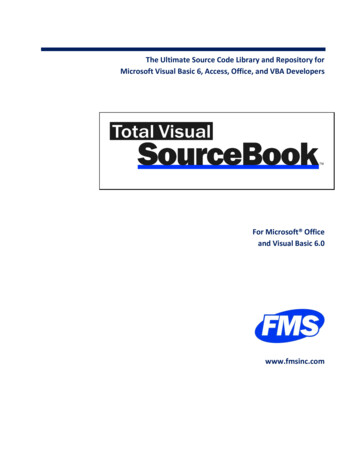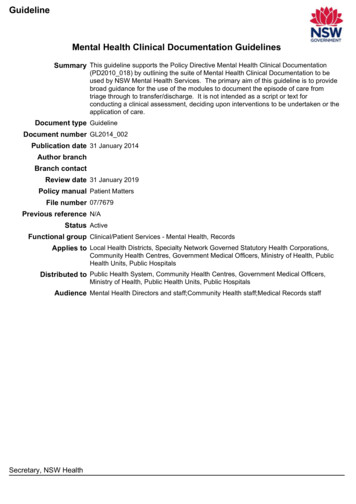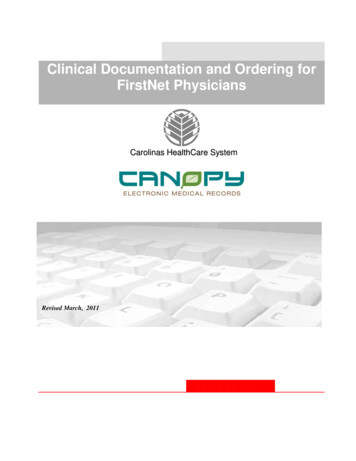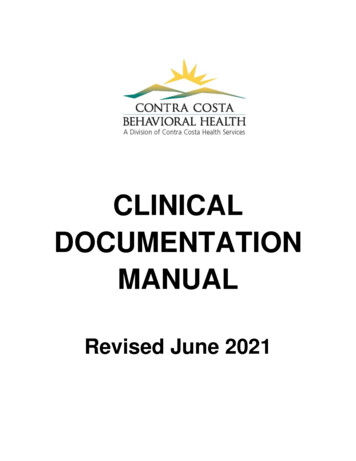
Transcription
The ClinicalDocumentationSourcebook
Practice Planners SeriesTreatment PlannersThe Complete Psychotherapy Treatment PlannerThe Child & Adolescent Psychotherapy Treatment PlannerThe Chemical Dependence Treatment PlannerThe Continuum of Care Treatment PlannerThe Couples Psychotherapy Treatment PlannerThe Employee Assistance Treatment PlannerThe Pastoral Counseling Treatment PlannerThe Older Adult Psychotherapy Treatment PlannerThe Behavioral Medicine Treatment PlannerHomework PlannersBrief Therapy Homework PlannerBrief Couples Therapy Homework PlannerChemical Dependence Homework PlannerChild and Adolescent Homework PlannerDocumentation SourcebooksClinical Documentation SourcebookThe Forensic Documentation SourcebookThe Psychotherapy Documentation PrimerThe Chemical Dependence Documentation SourcebookThe Clinical Child Documentation SourcebookCouples & Family Clinical Documentation SourcebookThe Clinical Documentation Sourcebook, Second Edition
The ClinicalDocumentationSourcebookA Comprehensive Collection ofMental Health Practice Forms,Handouts, and RecordsSecond EditionDonald E. WigerPostScriptPictureWILEY.EPSJohn Wiley & Sons, Inc.New York Chichester Weinheim Brisbane Singapore Toronto
This book is printed on acid-free paper.Copyright 1999 by John Wiley & Sons, Inc. All rights reserved.Published simultaneously in Canada.No part of this publication may be reproduced, stored in a retrieval system or transmitted in anyform or by any means, electronic, mechanical, photocopying, recording, scanning or otherwise,except as permitted under Section 107 or 108 of the 1976 United States Copyright Act, withouteither the prior written permission of the Publisher, or authorization through payment of theappropriate per-copy fee to the Copyright Clearance Center, 222 Rosewood Drive, Danvers, MA01923, (978) 750-8400, fax (978) 750-4744. Requests to the Publisher for permission should beaddressed to the Permissions Department, John Wiley & Sons, Inc., 605 Third Avenue, New York,NY 10158-0012, (212) 850-6011, fax (212) 850-6008, E-Mail: PERMREQ@WILEY.COM.This publication is designed to provide accurate and authoritative information in regard to thesubject matter covered. It is sold with the understanding that the publisher is not engaged inrendering professional services. If legal, accounting, medical, psychological or any other expertassistance is required, the services of a competent professional person should be sought.Designations used by companies to distinguish their products are often claimed as trademarks.In all instances where John Wiley & Sons, Inc. is aware of a claim, the product names appear ininitial capital or all capital letters. Readers, however, should contact the appropriate companies formore complete information regarding trademarks and registration.Diagnostic criteria taken from DSM-IV reprinted with permission from the Diagnostic and StatisticalManual of Mental Disorders, Fourth Edition. Copyright 1994 American Psychiatric Association.Note about Photocopy RightsThe publisher grants purchasers permission to reproduce handouts from this book for professional use withtheir clients.Library of Congress Cataloging-in-Publication Data:Wiger, Donald E., 1953–The clinical documentation sourcebook : a comprehensive collectionof mental health practice forms, handouts, and records / by Donald E.Wiger. — 2nd ed.p.cm. — (Practice planners series)Accompanied by one computer disk.ISBN 0-471-32692-5 (paper: alk. paper)1. Psychiatry—Medical records—Forms. 2. Mental health services—Medical records—Forms. I. Title. II. Series: Practice planners.[DNLM: 1. Mental Health Services—forms. 2. Documentation—methods—forms. 3. Medical Records—forms. WM 30W654c 1999]RC455.2.M38W541999616.89′ 0068—dc21DNLM/ DLCfor Library of Congress98-38798Printed in the United States of America.10987654321
This second edition is dedicated to my loving wife, Debra.There were so many times when I came homefrom work exhausted from seeing clients, but still had to writereports and then work on the book. You were alwaysthere to say a kind word and rub my back. Thank you.Let’s go out to eat tonight. My mother will watch the children.
Practice PlannerSeries PrefaceThe practice of psychotherapy has a dimension that did not exist 30, 20, or even 15 years ago—accountability. Treatment programs, public agencies, clinics, and even group and solo practitioners must now justify the treatment of patients to outside review entities that control the payment of fees. This developmenthas resulted in an explosion of paperwork.Clinicians must now document what has been done in treatment, what is planned for the future,and what the anticipated outcomes of the interventions are. The books and software in this PracticePlanner series are designed to help practitioners fulfill these documentation requirements efficientlyand professionally.The Practice Planner series is growing rapidly. It now includes not only the original Complete Psychotherapy Treatment Planner and the Child and Adolescent Psychotherapy Treatment Planner, but alsoTreatment Planners targeted to specialty areas of practice, including chemical dependency, the continuumof care, couples therapy, older adult treatment, employee assistance, pastoral counseling, and more.In addition to the Treatment Planners, the series also includes Therascribe : The Computerized Assistant to Psychotherapy Treatment Planning and TheraBiller : The Computerized Mental Health Of ficerManager, as well ad adjunctive books, such as the Brief Therapy, Chemical Dependence, Couples, and ChildHomework Planners, The Psychotherapy Documentation Primer, and Clinical, Forensic, Child, Couples andFamily, and Chemical Dependence Documentation Sourcebooks—containing forms and resources to aid inmental health practice management. The goal of the series is to provide practitioners with the resources theyneed in order to provide high-quality care in the era of accountability—or, to put it simply, we seek to helpyou spend more time on patients and less on paperwork.ARTHUR E. JONGSMA, JR.Grand Rapids, Michiganvii
PrefaceThe first edition of the Clinical Documentation Sourcebook aroused much interest in integrating psychological forms throughout the course of therapy. The ongoing examples of charting a client’s progress werehelpful to many clinicians. Several clinics have reported adopting the forms and have expressed a furtherinterest in more explanation of clinical documentation. Thus, The Clinical Documentation Primer, a textthat teaches specific documentation skills in diagnostic interviewing, treatment plans, and progress notesis published by John Wiley & Sons coinciding with publication of the second edition of this sourcebook.This second edition has added 50 percent more mental health forms compared to the previous edition.Changes have included more emphasis on biopsychosocial information, treatment plan updates, progressreports, and outcome indices. An added emphasis in integrating and coordinating personal history information and mental status information helps reduce redundant information. Current forms are designed tomeet JCAHO standards, thus both large and small mental health practices and organizations will benefit.The following forms have been added:Suicide Contract.Termination Letter.Initial Assessment—Adult.Initial Assessment—Child.Personal History Form—Adult.Personal History Form—Child.Emotional / Behavioral Update.Biopsychosocial Report.Diagnostic Assessment—Lower Functioning.Treatment Review.Treatment Update.Clinical Outcomes Questionnaire.Chart Review.ix
ContentsIntroduction . . . . . . . . . . . . . . . . . . . . . . . . . . . . . . . . . . . . . . . . . . . . xvChapter 1 Intake and Termination Forms and Procedures . . . . . . 1.1Initial Client Information FormForm 1 Sample Form . . . . . . . . . . . . . . . . . . . . . . . . . . . . . . . . . . . . . . . . . . . . . . . . . . . . . . 1.9Form 1A Example of Completed Form . . . . . . . . . . . . . . . . . . . . . . . . . . . . . . . . . . . . . . . . 1.10Financial Policy StatementForm 2 Sample Form . . . . . . . . . . . . . . . . . . . . . . . . . . . . . . . . . . . . . . . . . . . . . . . . . . . . . 1.11Payment Contract for ServicesForm 3 Sample Form . . . . . . . . . . . . . . . . . . . . . . . . . . . . . . . . . . . . . . . . . . . . . . . . . . . . . 1.12Limits of Confidentiality FormForm 4 Sample Form . . . . . . . . . . . . . . . . . . . . . . . . . . . . . . . . . . . . . . . . . . . . . . . . . . . . . 1.13Preauthorization for Health Care FormForm 5 Sample Form . . . . . . . . . . . . . . . . . . . . . . . . . . . . . . . . . . . . . . . . . . . . . . . . . . . . . 1.15Release of Information Consent FormForm 6 Sample Form . . . . . . . . . . . . . . . . . . . . . . . . . . . . . . . . . . . . . . . . . . . . . . . . . . . . . 1.16Suicide ContractForm 7 Sample Form . . . . . . . . . . . . . . . . . . . . . . . . . . . . . . . . . . . . . . . . . . . . . . . . . . . . . 1.17Discharge Summary FormForm 8 Sample Form . . . . . . . . . . . . . . . . . . . . . . . . . . . . . . . . . . . . . . . . . . . . . . . . . . . . . 1.18Form 8A Example of Completed Form . . . . . . . . . . . . . . . . . . . . . . . . . . . . . . . . . . . . . . . . 1.20Termination LetterForm 9 Sample Form . . . . . . . . . . . . . . . . . . . . . . . . . . . . . . . . . . . . . . . . . . . . . . . . . . . . . 1.22Chapter 2 Assessment for Counseling Forms and Procedures . . . 2.1Initial Assessment FormsForm 10 Sample Form—Adult . . . . . . . . . . . . . . . . . . . . . . . . . . . . . . . . . . . . . . . . . . . . . . 2.11Form 10A Example of Completed Form—Adult . . . . . . . . . . . . . . . . . . . . . . . . . . . . . . . . . 2.19xi
ContentsForm 11 Sample Form—Child . . . . . . . . . . . . . . . . . . . . . . . . . . . . . . . . . . . . . . . . . . . . . . 2.27Form 11A Example of Completed Form—Child . . . . . . . . . . . . . . . . . . . . . . . . . . . . . . . . . 2.35Biographical Information FormFormFormFormForm12 Sample Form—Adult . . . . . . . . . . . . .12A Example of Completed Form—Adult13 Sample Form—Child . . . . . . . . . . . . .13A Example of Completed onal History FormsFormFormFormForm14 Sample Form—Adult . . . . . . . . . . . . .14A Example of Completed Form—Adult15 Sample Form—Child . . . . . . . . . . . . .15A Example of Completed Form—ChildEmotional/Behavioral AssessmentForm 16 Sample Form . . . . . . . . . . . . . . . . . . . . . . . . . . . . . . . . . . . . . . . . . . . . . . . . . . . . 2.99Form 16A Example of Completed Form . . . . . . . . . . . . . . . . . . . . . . . . . . . . . . . . . . . . . . 2.103Emotional/Behavioral UpdateForm 17 Sample Form . . . . . . . . . . . . . . . . . . . . . . . . . . . . . . . . . . . . . . . . . . . . . . . . . . . 2.107Form 17A Example of Competed Form . . . . . . . . . . . . . . . . . . . . . . . . . . . . . . . . . . . . . . . 2.108Biopsychosocial ReportForm 18 Sample Form . . . . . . . . . . . . . . . . . . . . . . . . . . . . . . . . . . . . . . . . . . . . . . . . . . . 2.109Form 18A Example of Completed Form . . . . . . . . . . . . . . . . . . . . . . . . . . . . . . . . . . . . . . 2.112Diagnostic Assessment ReportForm 19 Sample Form . . . . . . . . . . . . . . . . . . . . . . . . . . . . . . . . . . . . . . . . . . . . . . . . . . . 2.115Form 19A Example of Completed Form . . . . . . . . . . . . . . . . . . . . . . . . . . . . . . . . . . . . . . 2.121Diagnostic Assessment—Lower FunctioningForm 20 Sample Form . . . . . . . . . . . . . . . . . . . . . . . . . . . . . . . . . . . . . . . . . . . . . . . . . . . 2.127Form 20A Example of Completed Form . . . . . . . . . . . . . . . . . . . . . . . . . . . . . . . . . . . . . . 2.131Chapter 3 Evaluation Forms and Procedures . . . . . . . . . . . . . . . . . 3.1Psychological EvaluationsFormFormFormForm21 Sample Form—Adult . . . . . . . . . . . . . . . . . . . . . . . . . . . . . . . . . . . . . . . . . . . . . . . 3.321A Example of Completed Form—Adult . . . . . . . . . . . . . . . . . . . . . . . . . . . . . . . . . 3.1622 Sample Form—Child . . . . . . . . . . . . . . . . . . . . . . . . . . . . . . . . . . . . . . . . . . . . . . 3.2922A Example of Completed Form—Child . . . . . . . . . . . . . . . . . . . . . . . . . . . . . . . . . 3.43Chapter 4 Treatment Plan Forms and Procedures . . . . . . . . . . . . . 4.1Individual Treatment PlansFormFormFormForm23 Sample Form—Child or Adult . . . . . . .23A Example of a Poor Treatment Plan . . .23B Example of a Completed Form—Adult23C Example of a Completed Form—Child. . . . . . . . . . . . . . . . . . . . . . . . . . . . . . . . . 4.7. . . . . . . . . . . . . . . . . . . . . . . . . . . . . . . . . 4.8. . . . . . . . . . . . . . . . . . . . . . . . . . . . . . . . . 4.9. . . . . . . . . . . . . . . . . . . . . . . . . . . . . . . . 4.10Short-Term Therapy Treatment PlanForm 24 Sample Form . . . . . . . . . . . . . . . . . . . . . . . . . . . . . . . . . . . . . . . . . . . . . . . . . . . . 4.11Form 24A Example of a Completed Form . . . . . . . . . . . . . . . . . . . . . . . . . . . . . . . . . . . . . . 4.12Treatment ReviewForm 25 Sample Form . . . . . . . . . . . . . . . . . . . . . . . . . . . . . . . . . . . . . . . . . . . . . . . . . . . . 4.13Form 25A Example of Completed Form . . . . . . . . . . . . . . . . . . . . . . . . . . . . . . . . . . . . . . . 4.15xii
ContentsTreatment UpdateForm 26 Sample Form . . . . . . . . . . . . . . . . . . . . . . . . . . . . . . . . . . . . . . . . . . . . . . . . . . . . 4.17Form 26A Example of Completed Form . . . . . . . . . . . . . . . . . . . . . . . . . . . . . . . . . . . . . . . 4.18Chapter 5 Progress Notes and Prior Authorization RequestForms and Procedures . . . . . . . . . . . . . . . . . . . . . . . . . . 5.1Sample Progress NotesFormFormFormForm27 Sample Form . . . . . . . . . . . . . . . . . . . . . . . . . . . . . . . . . . . . . . . . . . . . . . . . . . . . . 5.927A Example of a Poor Progress Note . . . . . . . . . . . . . . . . . . . . . . . . . . . . . . . . . . . . 5.1027B Example of Completed Form—Adult . . . . . . . . . . . . . . . . . . . . . . . . . . . . . . . . . 5.1127C Example of Completed Form—Child . . . . . . . . . . . . . . . . . . . . . . . . . . . . . . . . . 5.12Progress Notes—OutlineForm 28 Sample Form . . . . . . . . . . . . . . . . . . . . . . . . . . . . . . . . . . . . . . . . . . . . . . . . . . . . 5.13Form 28A Example of Completed Form . . . . . . . . . . . . . . . . . . . . . . . . . . . . . . . . . . . . . . . 5.14Group Therapy Progress NotesForm 29 Sample Form . . . . . . . . . . . . . . . . . . . . . . . . . . . . . . . . . . . . . . . . . . . . . . . . . . . . 5.15Form 29A Example of Completed Form . . . . . . . . . . . . . . . . . . . . . . . . . . . . . . . . . . . . . . . 5.16Third-Party Prior Authorization Request for Continued ServicesForm 30 Examples of Completed Form (Bad P.A.) . . . . . . . . . . . . . . . . . . . . . . . . . . . . . . . 5.17Form 30A Examples of Completed Form (Good P.A.) . . . . . . . . . . . . . . . . . . . . . . . . . . . . . 5.18Clinical Outcomes QuestionnaireForm 31 Sample Form . . . . . . . . . . . . . . . . . . . . . . . . . . . . . . . . . . . . . . . . . . . . . . . . . . . . 5.19Chart ReviewForm 32 Sample Form . . . . . . . . . . . . . . . . . . . . . . . . . . . . . . . . . . . . . . . . . . . . . . . . . . . . 5.20Chapter 6 Relationship Counseling Forms and Procedures . . . . . . 6.1Marital and Couple’s Information FormsForm 33 Sample Form—Marital . . . . . . . . . . . . . . . . . . . . . . . . . . . . . . . . . . . . . . . . . . . . . . 6.4Form 34 Sample Form—Couples . . . . . . . . . . . . . . . . . . . . . . . . . . . . . . . . . . . . . . . . . . . . . 6.9Analysis of Target BehaviorsForm 35 Sample Form . . . . . . . . . . . . . . . . . . . . . . . . . . . . . . . . . . . . . . . . . . . . . . . . . . . . 6.14Form 35A Example of Completed Form . . . . . . . . . . . . . . . . . . . . . . . . . . . . . . . . . . . . . . . 6.16Cooperating in Child RearingForm 36 Sample Form . . . . . . . . . . . . . . . . . . . . . . . . . . . . . . . . . . . . . . . . . . . . . . . . . . . . 6.18Sharing Your FeelingsForm 37 Sample Form . . . . . . . . . . . . . . . . . . . . . . . . . . . . . . . . . . . . . . . . . . . . . . . . . . . . 6.23Form 37A Example of Completed Form . . . . . . . . . . . . . . . . . . . . . . . . . . . . . . . . . . . . . . . 6.25Bibliography and Suggested Readings . . . . . . . . . . . . . . . . . . . . . . . . . . . . B.1About the Disk . . . . . . . . . . . . . . . . . . . . . . . . . . . . . . . . . . . . . . . . . . . . . . . D.1xiii
IntroductionFew mental health professionals have received graduate training in documentation procedures. Learning to write case notes, treatment plans, and other documentation is usually a trial-and-error process,often resulting in vague treatment plans, case notes, and therapy. Historically, case notes and treatmentplans have been required in most mental health care settings, but few standardized procedures havebeen acknowledged. In many cases, the mere existence of various forms and documents in clients’ fileswas sufficient.Historically, documentation procedures in medical fields other than mental health have been quitestringent, requiring that specific interventions be accurately charted. Without such documentation, physicians and nurses are understandably vulnerable to litigation. But prior to the emergence of managed care,most mental health professions received little scrutiny by third-party payers in areas of accountability.Managed care changed the rules by raising the standards of documentation procedures in the mentalhealth field.For managed care companies to obtain contracts, they must attempt to provide the best services forthe least money. Often, a few managed care companies cover a significant number of people in a given geographic area. To receive a sufficient number of referrals, mental health providers contract with thesecompanies, but may become dissatisfied with demanding documentation rules and regulations.Graduate training programs have concentrated on traditional therapeutic methods, teaching therapists to attend to clients, conceptualize cases, listen empathically, render interpretations, ease clients’emotional pain, provide direction, and slowly taper off the sessions to prevent relapse. Although such procedures and interventions are therapeutically necessary, third-party requirements rarely mention thembecause in themselves they do not necessarily document the efficacy and course of therapy. Instead,terms often not learned in graduate school such as “medical necessity,” “ functional impairment,” and“discharge criteria” have become the criteria for continued services.Procedural requirements and changes catalyzed by managed care for documentation of therapy haveincreased cognitive dissonance in mental health professionals. Dissonance has developed because therapists are being challenged by discrepancies between their established mental health procedures and seemingly conflicting new requirements that are often viewed as limiting the clinician’s therapeutic freedom.The resulting cognitive dissonance leads to stress, discomfort, worry, and complaints. To say that managed care regulations and procedures have caused cognitive dissonance is an understatement like the observations that “Sigmund Freud had some sort of effect on psychology” or “Albert Einstein was smart.”It is possible to reduce cognitive dissonance by focusing on the benefits of documentation procedures. Effective documentation holds mental health professionals accountable for accurate diagnosis, concise treatment planning, case notes that follow the treatment plan, treatment reflecting the diagnosis, anddocumentation of the course of therapy.xv
IntroductionEffective case notes can be written in a manner that would enable a new therapist to review a file andclearly determine specific impairments, the effectiveness of previous treatment strategies, client compliance, progress and setbacks.Treatment does not necessarily have to change, but documentation procedures validating the effectiveness of treatment must be learned in order for mental health services to survive in the world of managed care. The ethical implications of being accountable (or not being accountable) for work deservesattention.Managed care has brought the mental health profession up to par with other health care professionalsin accountability procedures. In other areas of health care, the “ black box” treatment approach—in whichspecific interventions are not documented—would be considered unethical, not reimbursable, and open tolitigation. Without clear documentation procedures there is little or no accountability, leaving professionals open to allegations of fraud due to lack of specific evidence that necessary services are being provided.For example, one major managed care company (Blue Cross/ Blue Shield) has established the following (selected) requirements and criteria for mental health services to be eligible for benefits:1. “Services must be medically and/or therapeutically necessary.” Medical necessity is determinedby “ the presence of significant impairment or dysfunction in the performance of activitiesand/or responsibilities of daily living as a result of a mental disorder.” Note that the emphasis ison the impairment, not simply the diagnosis. Although most third-party payers require an Axis Idiagnosis, it is the resulting impairment that is the focus of interventions.2. “ Therapeutic necessity is defined as services consistent with the diagnosis and impairmentwhich are non-experimental in nature and can be reliably predicted to positively affect the patient’s condition.” Therapeutic interventions must have a positive track record for the particulardiagnosis and impairments. Charting procedures that do not clearly and consistently reflect suchinterventions do not document therapeutic necessity.3. “ The intensity of treatment must be consistent with the acuity and severity of the patient’s current level of impairment and/or dysfunction.” Without regular documentation of current functioning (session by session) and a rationale for the intensity of treatment, no evidence exists.4. “ There must be documentation of reasonable progress consistent with the intensity of treatmentand the severity of the disorder.” Case notes must validate the effectiveness of the current therapeutic interventions and justify the frequency of sessions.5. “. . . documented, specific evidence of a diagnosable mental disorder ( based on current DSM). Thediagnosis must be validated by Diagnostic and Statistical Manual of Mental Disorders (DSM) criteria. A diagnosis is more than an opinion: Specific symptoms must be documented according to current DSM-IV criteria.6. “ The treatment plan includes specific, objective, behavioral goals for discharge.” Both the clientand the therapist have agreed on discharge criteria, stated in behavioral measures.7. Justification to continue treatment includes “persistence of significant symptoms and impairment or dysfunction resultant from mental illness which required continued treatment includingimpaired social, familial or occupational functioning or evidence of symptoms which reflectspotential dangers to self, others and/or property.” Case notes must regularly document the persistence of impairment. Without this documentation, there is no evidence and therefore the impairment and diagnosis no longer exist (as far as documentation is concerned). It is possible thatxvi
Introductiona significant impairment may exist, but if it is not appropriately documented, payment for services could be discontinued.8. “Insufficient behavioral and/or dysfunctional evidence is present to support the current diagnosis.” Not only must impairments be documented, but the DSM Axis I diagnosis must be documented with evidence throughout the course of therapy. If the diagnosis is not supportedthroughout the case notes, there is no evidence, and therefore third-party payment may be halted.9. “Lack of therapeutic appropriateness and/or lack of therapeutic progress.” Evidence of therapeutic gains and setbacks are required documentation procedures.10. Noncovered services include services without a “definite treatment plan,” services without corresponding documentation, medically unnecessary services, services without a diagnosable mental disorder, and several other uncovered services.This summary of third-party documentation procedures indicates specific requirements that are designed to document the efficacy of therapy in such areas as validation of diagnosis, functional impairments, symptoms, treatment, client cooperation, and providing behavioral evidence of gains and setbacksin treatment. Benefits of learning these procedures range from increased prior authorization approval foradditional sessions, to clearer focus in therapy, to audit survival.Sample forms and related examples of several documentation procedures from the initial client contact to the discharge summary are included. Blank forms are provided along with several of the formsfilled out. Unless a form is self-explanatory, explanations are provided on its use. Special emphasis isplaced on treatment plans and case notes.OrganizationThis book is organized into six chapters of forms and procedures in the areas of intake and termination,assessment for counseling, evaluations, treatment plans, case notes, and relationship counseling.Brief explanations of each form are followed by blank forms, and where forms are complex, filled outforms are provided. Blank forms are provided on the disk in the back of the book. An ongoing case example of Judy Doe is used in many of the documentation procedures and forms.xvii
Chapter 1Intake and TerminationForms and ProceduresThe mental health clinic’s intake information forms elicit demographic and payment information aboutthe client. They also communicate business, legal, and ethical issues and responsibilities. Although initialintake forms do not provide specific clinical information, they do provide an understanding of the responsibilities of both the client and the clinic. In each case, these forms are taken care of prior to the firstcounseling session. All insurance and financial agreements are contracted with the client before servicesbegin. The clinic’s financial policies must be clearly spelled out. In addition, the client should be madeaware of, and agree to, the limits of confidentiality in a counseling session.Common client questions are: “What if my insurance company does not pay?,” “How confidential isthe session?,” “Do parents have the right to their children’s records?,” “What happens if payment is notreceived?,” “What happens if suicide is mentioned?,” and “What is the price of therapy?” These and otherquestions are not only answered, but also documented and signed. Any of these issues, if not covered,could lead to misunderstanding, subsequent premature termination of treatment, ethics changes, or a lawsuit. Intake forms provide clear communication between the client and clinic, with the aim of eliminatingmisunderstandings detrimental to the therapeutic process and clinic survival.1.1
Chapter 1FORM 1Initial Client Information FormThe initial intake information form (Form 1) is filled out at the time of the referral or initial client contact with the mental health care provider. Information solicited from the client includes basic demographic, plus insurance identification information. For insurance reasons, information requested from theclient should minimally include: Policyholder information: name, date of birth, social security number, policy number. Similar information from family members receiving services. Name of employer. Name and telephone number of each third-party payer.If the mental health care provider processes insurance information, it is crucial to verify benefits from theinsurance company. Specific questions should be asked of the third party, minimally including the following: Persons covered by the policy. Deductible amount and amount currently satisfied. Co-payment amounts. Limits of policy. Covered/noncovered services (e.g., individual, family, relationship). Prior authorizations needed. Coverage and policies for testing. Supervision required for various providers. Type(s) of provider(s) covered for services (e.g., psychologist, social worker counselor). Policy anniversary date.When this information is unclear or unknown, there is room for misunderstanding between the mental health care provider and the client. Clients usually believe that all services performed in therapy arecovered by their insurance. But mental health benefits from several sources are decreasing, and only specific, limited services are now covered. For example, just a few years ago several third-party payers paidfor testing; today testing is seldom considered a standard procedure and often needs prior approval. Another trend is that most managed-care companies approve only a few sessions at a time, while in the pastfew restrictions were made.Initial insurance information provided by third-party payers is not a guarantee of benefits. Each mental health care provider should have a clear financial policy and payment contract (possibly on the sameform) to explain conditions of payment in the event that the third-party payer denies payment.1.2
Intake and Termination Forms and ProceduresFORM 2Financial Policy StatementClinical skills are necessary, but not the sole component i
The Complete Psychotherapy Treatment Planner The Child & Adolescent Psychotherapy Treatment Planner The Chemical Dependence Treatment Planner The Continuum of Care Treatment Planner The Couples Psychotherapy Treatment Planner The Employee Assistance Treatment Planner The Pastoral Counse











